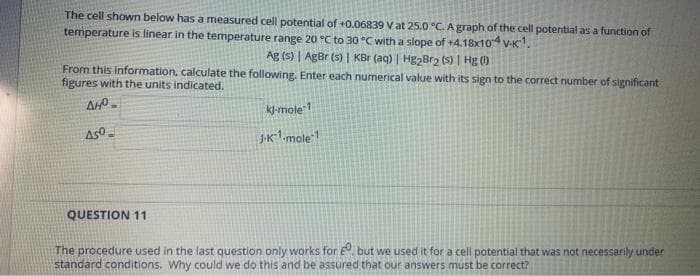The cell shown below has a measured cell potential of +0.06839 V at 25.0 °C. A graph of the cell potential as a function of temperature is linear in the temperature range 20 °C to 30 °C with a slope of +4.18x10 V-K. Ag (s) | AgBr (5) | KBr (aq) | Hg2Bra (S) | Hg () From this information, calculate the following. Enter each numerical value with its sign to the correct number of significant figures with the units indicated. kl-mole 450 JK1.mole
The cell shown below has a measured cell potential of +0.06839 V at 25.0 °C. A graph of the cell potential as a function of temperature is linear in the temperature range 20 °C to 30 °C with a slope of +4.18x10 V-K. Ag (s) | AgBr (5) | KBr (aq) | Hg2Bra (S) | Hg () From this information, calculate the following. Enter each numerical value with its sign to the correct number of significant figures with the units indicated. kl-mole 450 JK1.mole
Principles of Modern Chemistry
8th Edition
ISBN:9781305079113
Author:David W. Oxtoby, H. Pat Gillis, Laurie J. Butler
Publisher:David W. Oxtoby, H. Pat Gillis, Laurie J. Butler
Chapter17: Electrochemistry
Section: Chapter Questions
Problem 59P
Related questions
Question
7

Transcribed Image Text:The cell shown below has a measured cell potential of +0.06839 V at 25.0 °C. A graph of the cell potential as a function of
temperature is linear in the temperature range 20 °C to 30 °C with a slope of +4.18x104 v-K.
Ag (s) | AgBr (5) | KBr (aq) | Hg2Br2 (s) | Hg ()
From this information, calculate the following. Enter each numerical value with its sign to the correct number of significant
figures with the units indicated.
kj-mole 1
As0
JK1.mole"
QUESTION 11
The procedure used in the last question only works for E, but we used it for a cell potential that was not necessarily under
standard conditions. Why could we do this and be assured that our answers must be correct?
Expert Solution
This question has been solved!
Explore an expertly crafted, step-by-step solution for a thorough understanding of key concepts.
Step by step
Solved in 2 steps with 2 images

Knowledge Booster
Learn more about
Need a deep-dive on the concept behind this application? Look no further. Learn more about this topic, chemistry and related others by exploring similar questions and additional content below.Recommended textbooks for you

Principles of Modern Chemistry
Chemistry
ISBN:
9781305079113
Author:
David W. Oxtoby, H. Pat Gillis, Laurie J. Butler
Publisher:
Cengage Learning

Chemistry: The Molecular Science
Chemistry
ISBN:
9781285199047
Author:
John W. Moore, Conrad L. Stanitski
Publisher:
Cengage Learning

Chemistry: Principles and Practice
Chemistry
ISBN:
9780534420123
Author:
Daniel L. Reger, Scott R. Goode, David W. Ball, Edward Mercer
Publisher:
Cengage Learning

Principles of Modern Chemistry
Chemistry
ISBN:
9781305079113
Author:
David W. Oxtoby, H. Pat Gillis, Laurie J. Butler
Publisher:
Cengage Learning

Chemistry: The Molecular Science
Chemistry
ISBN:
9781285199047
Author:
John W. Moore, Conrad L. Stanitski
Publisher:
Cengage Learning

Chemistry: Principles and Practice
Chemistry
ISBN:
9780534420123
Author:
Daniel L. Reger, Scott R. Goode, David W. Ball, Edward Mercer
Publisher:
Cengage Learning


Chemistry
Chemistry
ISBN:
9781305957404
Author:
Steven S. Zumdahl, Susan A. Zumdahl, Donald J. DeCoste
Publisher:
Cengage Learning
